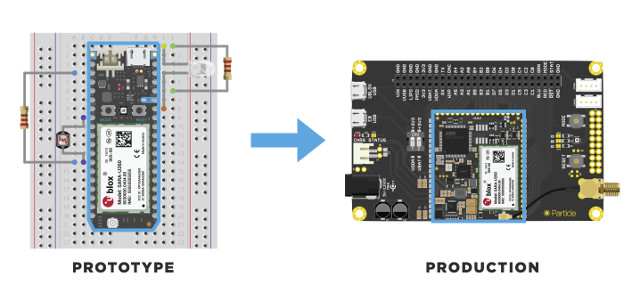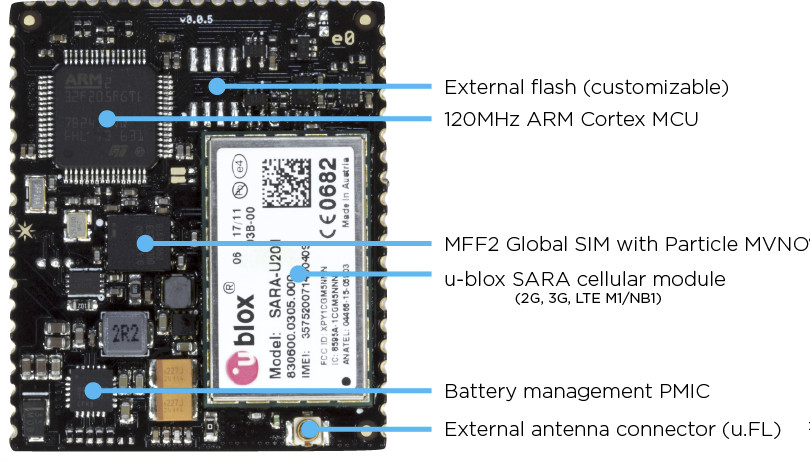Cellular IoT has really taken off this year from the low cost Orange Pi 2G IoT board to 4G GPS Trackers, and global IoT SIM cards. Particle has been in this market for a couple of years, starting with their Electron boards, and the company has just announced the new Particle E series family of industrialized 2G, 3G, and LTE-enabled modules and a development kit.
Key features of Particles E series modules:
- Cellular Connectivity
- u-blox SARA modules for cellular connectivity
- LTE: SARA-R410M
- 3G: SARA-U201/U260/U270
- 2G: SARA-G350 (2G)
- Embedded SIM card, Particle MVNO support in 100+ countries
- u.FL antenna connector
- u-blox SARA modules for cellular connectivity
- MCU – STM32F205RGT6 120MHz ARM Cortex M3 microcontroller with 1MB flash, 128KB RAM
- Storage – • Expandable flash memory
- I/Os – 63-pin surface mountable castellated module with up 30x GPIOs, 12x ADC, 2x DAC, 13x PWM, 3x UART, 2x SPI, 1x I2S, 2x CAN, 1x USB 2.0 (Some signals are multiplexed)
- Power Supply – 3.88 to 12V input; BQ24195 power management unit and battery charger; MAX17043 fuel gauge
- Power Consumption (@5V?)
- Operating current (cellular ON): 180 mA to 250 mA
- Operating current (cellular OFF): 47 mA to 50 mA
- Peak current: 800mA (3G), 1800 mA (2G)
- Sleep Current: 0.8 mA to 2 mA
- Dimensions – 43 x 36 x 4.6 mm
- Weight – < 10 grams
- Temperature Range – -20 to +85°C (extended range)
- Certifications – FCC, CE, IC wireless certifications, PTCRB (End-Product Certified) & GCF cellular certifications, RoHS
A total of 7 modules are planned to launch by mid 2018 with the naming convention using the first number reserved for the “G” number, the second for local (0) or global (1), and the third being an incremental number:
- E210 – 2G only – Q4 2017 working worldwide (quad band)
- E301 – 3G with 2G fallback – Q4 2017 for Americas/Australia (850/1900 MHz)
- E302 – 3G with 2G fallback – Q4 2017 for Europe, Asia, and Africa (900/1800/2100 MHz)
- E310 – 3G with 2G fallback – Q4 2017 working worldwide (850/900/1800/1900/2100 MHz)
- E401 – LTE M1 – Early 2018 for US (LTE B13)
- E402 – LTE M1 – Early 2018 for North America (LTE B2/4/5/12)
- E410 – LTE M1/NB1 – Mid 2018 for the global market

The new modules share the same software development tools, Particle Cloud platform, code and peripherals as Electron prototyping board with the modules running FreeRTOS, supporting CoAP encrypted messaging, TCP/IP and UDP/IP, GCC toolchain, and various firmware update methods including OTA. E series were created because while Electron board suitable for evaluation, pin-row headers, plastic SIM cards, and USB connectors made it less appropriate for integration into products and mass production.
The company has also introduced an E Series evaluation kit working globally with the following specifications:
- Module – Particle E310 3G with 2G fallback
- Breakout Board with
- 2x micro USB port for flashing and serial communications
- SMA antenna connector
- 1x female expansion header, 2x Grove connectors
- Misc – MODE and RESET buttons, Charge and status LEDs
- Power – Li-Po battery connector, power barrel jack
- Battery – 2,000 mAh Li-Po battery
- Antenna – Taoglas penta-band antenna (u.FL), SMA to u.FL adapter for connecting external SMA antennas
- 1x Grove temperature sensor
- 1x USB Micro cable
- Pinout reference card
The kit will come with three months of Particle’s 1MB monthly data plan upon eSIM activation. Data plan pricing depends on the country of operation and number of nodes, but for reference, for up to 100 nodes in the US, you’d pay $2.99 per month/device including 1MB data, plus $0.99 per extra MB.
Pricing information has not been publicly disclosed for the module, but you can purchase E series development kit for $99.99, or $249 with 3 extra spare E310 modules. Visit Particle E-Series product page for further details.

Jean-Luc started CNX Software in 2010 as a part-time endeavor, before quitting his job as a software engineering manager, and starting to write daily news, and reviews full time later in 2011.
Support CNX Software! Donate via cryptocurrencies, become a Patron on Patreon, or purchase goods on Amazon or Aliexpress





